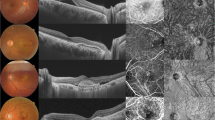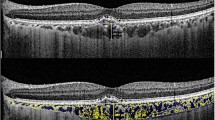Abstract
Purpose
To investigate the subfoveal choroidal thickness in eyes with typical age-related macular degeneration (AMD) and polypoidal choroidal vasculopathy (PCV), using enhanced depth imaging optical coherence tomography.
Methods
Retrospective observational case series of 44 eyes of 44 patients (12 females and 32 males) with typical AMD or PCV located in the subfoveal region. Cross-sectional images of the choroid of each of the involved eyes were obtained by a spectral-domain OCT. The choroidal thickness under the fovea was retrospectively studied.
Results
Of the 44 eyes involved in this study, 21 eyes were diagnosed as typical AMD and the other 23 eyes were diagnosed as PCV. The difference in subfoveal choroidal thickness between the eyes with typical AMD (245 μm) and those with PCV (293 μm) was statistically significant, even after adjusting for age, spherical equivalent, and gender distribution (P = 0.045). When compared to eyes with subfoveal choroidal thickness less than 300 μm, those with subfoveal choroidal thickness of 300 μm or more were 5.6 times more likely to have PCV (adjusted odds ratio 5.60, 95% confidence interval 1.30–24.0, P = 0.021).
Conclusions
The choroid under the fovea was thicker in eyes with PCV than those with typical AMD. This result suggests that the choroidal vascular lesion seen in PCV may not be just the choroidal neovascularization accompanied by saccular capillary dilations at the border, but may have a significant structural difference in the choroid compared to typical AMD.



Similar content being viewed by others
References
Yannuzzi LA, Ciardella A, Spaide RF, Rabb M, Freund KB, Orlock DA (1997) The expanding clinical spectrum of idiopathic polypoidal choroidal vasculopathy. Arch Ophthalmol 115:478–485
Spaide RF, Yannuzzi LA, Slakter JS, Sorenson J, Orlach DA (1995) Indocyanine green videoangiography of idiopathic polypoidal choroidal vasculopathy. Retina 15:100–110
Sho K, Takahashi K, Yamada H, Wada M, Nagai Y, Otsuji T, Nishikawa M, Mitsuma Y, Yamazaki Y, Matsumura M, Uyama M (2003) Polypoidal choroidal vasculopathy: incidence, demographic features, and clinical characteristics. Arch Ophthalmol 121:1392–1396
Maruko I, Iida T, Saito M, Nagayama D, Saito K (2007) Clinical characteristics of exudative age-related macular degeneration in Japanese patients. Am J Ophthalmol 144:15–22
Wen F, Chen C, Wu D, Li H (2004) Polypoidal choroidal vasculopathy in elderly Chinese patients. Graefes Arch Clin Exp Ophthalmol 242:625–629
Yannuzzi LA, Wong DW, Sforzolini BS, Goldbaum M, Tang KC, Spaide RF, Freund KB, Slakter JS, Guyer DR, Sorenson JA, Fisher Y, Maberley D, Orlock DA (1999) Polypoidal choroidal vasculopathy and neovascularized age-related macular degeneration. Arch Ophthalmol 117:1503–1510
Uyama M, Matsubara T, Fukushima I, Matsunaga H, Iwashita K, Nagai Y, Takahashi K (1999) Idiopathic polypoidal choroidal vasculopathy in Japanese patients. Arch Ophthalmol 117:1035–1042
Liu Y, Wen F, Huang S, Luo G, Yan H, Sun Z, Wu D (2007) Subtype lesions of neovascular age-related macular degeneration in Chinese patients. Graefes Arch Clin Exp Ophthalmol 245:1441–1445
Spaide RF, Koizumi H, Pozonni MC (2008) Enhanced depth imaging spectral-domain optical coherence tomography. Am J Ophthalmol 146:496–500
Margolis R, Spaide RF (2009) A pilot study of enhanced depth imaging optical coherence tomography of the choroid in normal eyes. Am J Ophthalmol 147:811–815
Fujiwara T, Imamura Y, Margolis R, Slakter JS, Spaide RF (2009) Enhanced depth imaging optical coherence tomography of the choroid in highly myopic eyes. Am J Ophthalmol 148:445–450
Otsuji T, Takahashi K, Fukushima I, Uyama M (2000) Optical coherence tomographic findings of idiopathic polypoidal choroidal vasculopathy. Ophthalmic Surg Lasers 31:210–214
Lafaut BA, Aisenbrey S, Van den Broecke C, Bartz-Schmidt KU, Heimann K (2000) Polypoidal choroidal vasculopathy pattern in age-related macular degeneration: a clinicopathologic correlation. Retina 20:650–654
Rosa RH Jr, Davis JL, Eifrig CW (2002) Clinicopathologic reports, case reports, and small case series: clinicopathologic correlation of idiopathic polypoidal choroidal vasculopathy. Arch Ophthalmol 120:502–508
Terasaki H, Miyake Y, Suzuki T, Nakamura M, Nagasaka T (2002) Polypoidal choroidal vasculopathy treated with macular translocation: clinical pathological correlation. Br J Ophthalmol 86:321–327
MacCumber MW, Dastgheib K, Bressler NM, Chan CC, Harris M, Fine S, Green WR (1994) Clinicopathologic correlation of the multiple recurrent serosanguineous retinal pigment epithelial detachments syndrome. Retina 14:143–152
Iijima H, Imai M, Gohdo T, Tsukahara S (1999) Optical coherence tomography of idiopathic polypoidal choroidal vasculopathy. Am J Ophthalmol 127:301–305
Nakajima M, Yuzawa M, Shimada H, Mori R (2004) Correlation between indocyanine green angiographic findings and histopathology of polypoidal choroidal vasculopathy. Jpn J Ophthalmol 48:249–255
Yuzawa M, Mori R, Kawamura A (2005) The origins of polypoidal choroidal vasculopathy. Br J Ophthalmol 89:602–607
Okubo A, Sameshima M, Uemura A, Kanda S, Ohba N (2002) Clinicopathological correlation of polypoidal choroidal vasculopathy revealed by ultrastructural study. Br J Ophthalmol 86:1093–1098
Kuroiwa S, Tateiwa H, Hisatomi T, Ishibashi T, Yoshimura N (2004) Pathological features of surgically excised polypoidal choroidal vasculopathy membranes. Clin Experiment Ophthalmol 32:297–302
Moorthy RS, Lyon AT, Rabb MF, Spaide RF, Yannuzzi LA, Jampol LM (1998) Idiopathic polypoidal choroidal vasculopathy of the macula. Ophthalmology 105:1380–1385
Nakashizuka H, Mitsumata M, Okisaka S, Shimada H, Kawamura A, Mori R, Yuzawa M (2008) Clinicopathologic findings in polypoidal choroidal vasculopathy. Invest Ophthalmol Vis Sci 49:4729–4737
Sasahara M, Tsujikawa A, Musashi K, Gotoh N, Otani A, Mandai M, Yoshimura N (2006) Polypoidal choroidal vasculopathy with choroidal vascular hyperpermeability. Am J Ophthalmol 142:601–607
Imamura Y, Fujiwara T, Margolis R, Spaide RF (2009) Enhanced depth imaging optical coherence tomography of the choroid in central serous chorioretinopathy. Retina 29:1469–1473
Ahuja RM, Downes SM, Stanga PE, Koh AH, Vingerling JR, Bird AC (2001) Polypoidal choroidal vasculopathy and central serous chorioretinopathy. Ophthalmology 108:1009–1010
Yannuzzi LA, Freund KB, Goldbaum M, Scassellati-Sforzolini B, Guyer DR, Spaide RF, Maberley D, Wong DW, Slakter JS, Sorenson JA, Fisher YL, Orlock DA (2000) Polypoidal choroidal vasculopathy masquerading as central serous chorioretinopathy. Ophthalmology 107:767–777
Gomi F, Ohji M, Sayanagi K, Sawa M, Sakaguchi H, Oshima Y, Ikuno Y, Tano Y (2008) One-year outcomes of photodynamic therapy in age-related macular degeneration and polypoidal choroidal vasculopathy in Japanese patients. Ophthalmology 115:141–146
Gomi F, Sawa M, Sakaguchi H, Tsujikawa M, Oshima Y, Kamei M, Tano Y (2008) Efficacy of intravitreal bevacizumab for polypoidal choroidal vasculopathy. Br J Ophthalmol 92:70–73
Author information
Authors and Affiliations
Corresponding author
Additional information
Grant information
This study was supported in part by Grant No.21890226 from Ministry of Education, Culture, Sports, Science and Technology–Japan (Dr. Koizumi).
Disclosures
The authors have no financial interests related to the material in the manuscript.
Rights and permissions
About this article
Cite this article
Koizumi, H., Yamagishi, T., Yamazaki, T. et al. Subfoveal choroidal thickness in typical age-related macular degeneration and polypoidal choroidal vasculopathy. Graefes Arch Clin Exp Ophthalmol 249, 1123–1128 (2011). https://doi.org/10.1007/s00417-011-1620-1
Received:
Revised:
Accepted:
Published:
Issue Date:
DOI: https://doi.org/10.1007/s00417-011-1620-1




